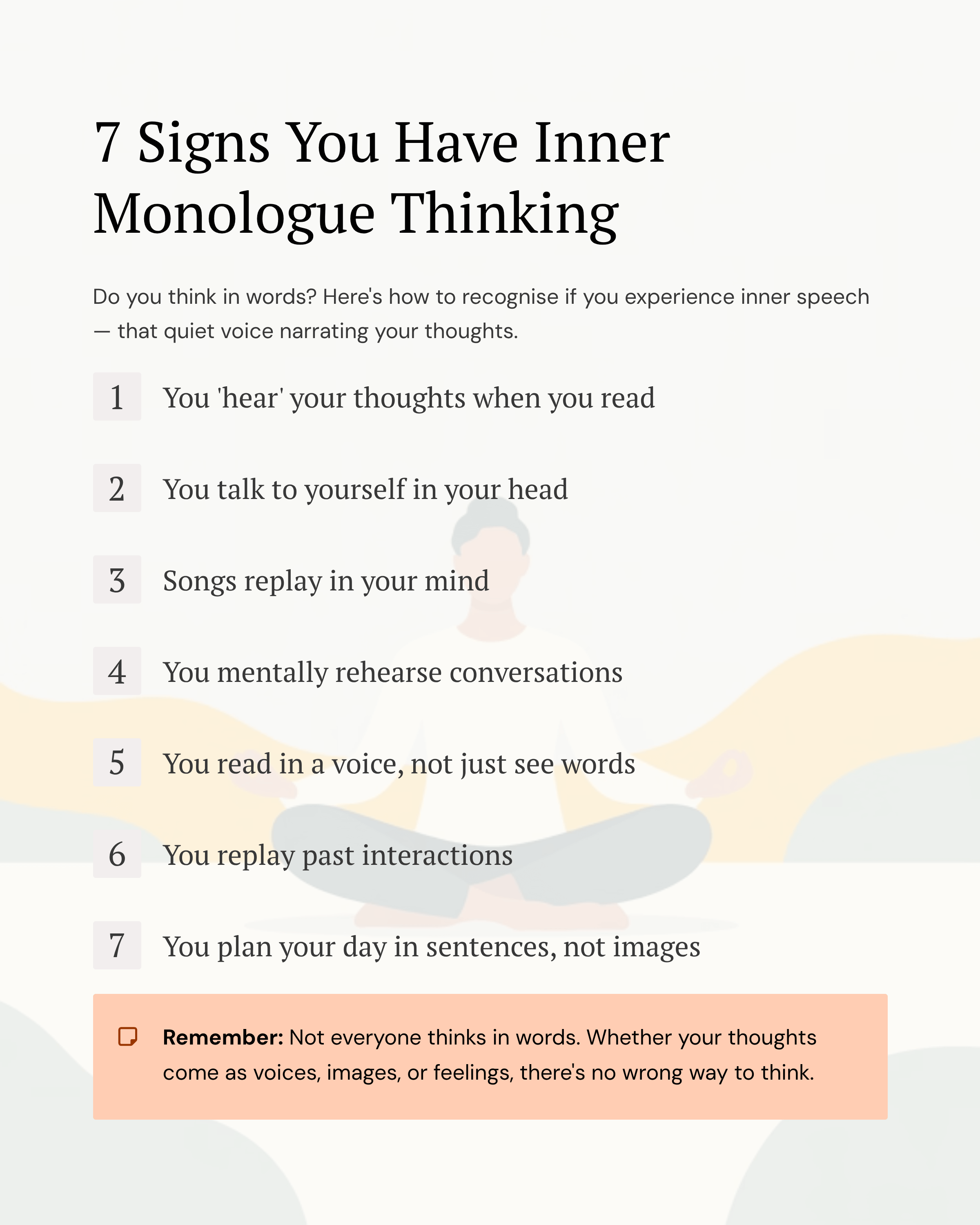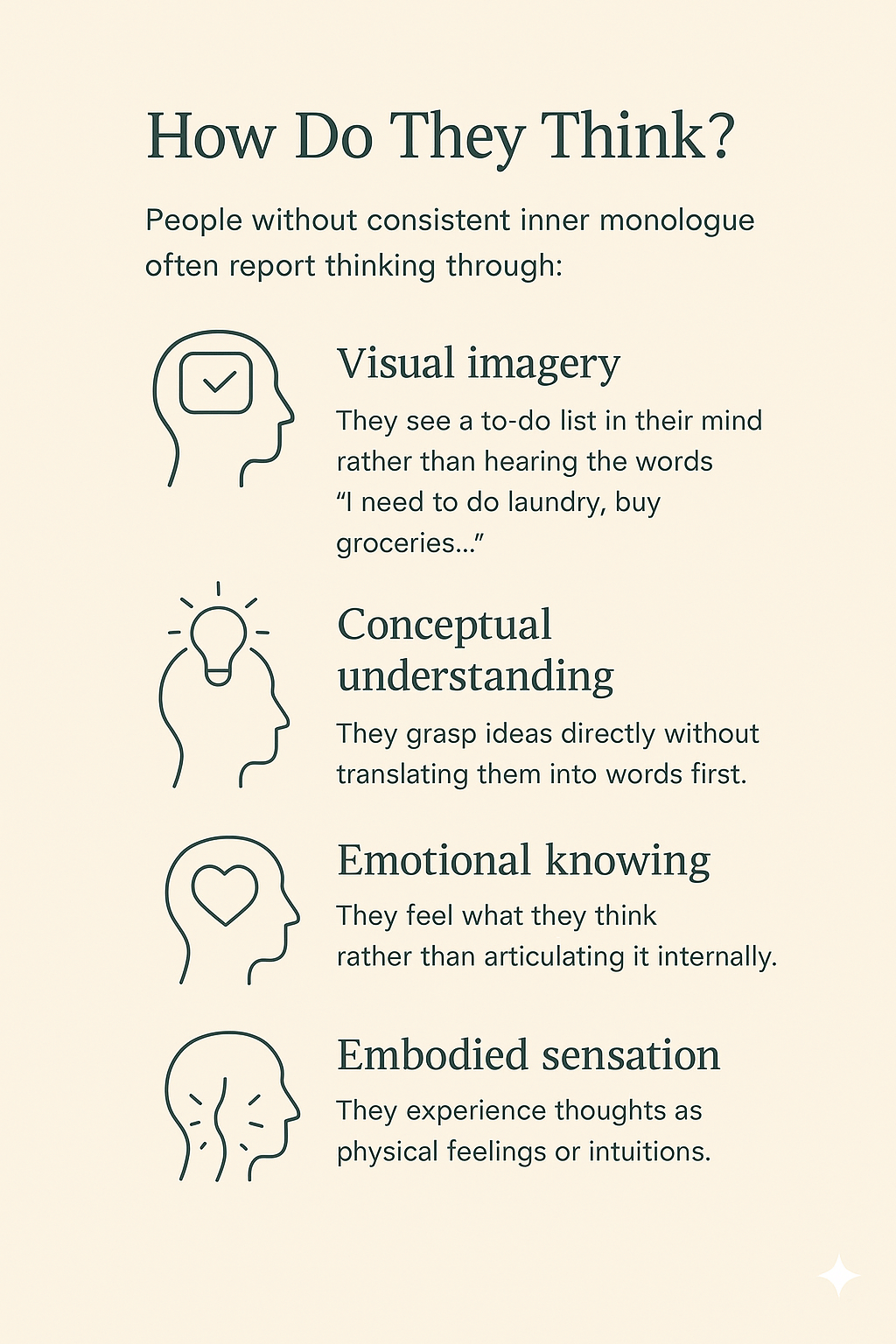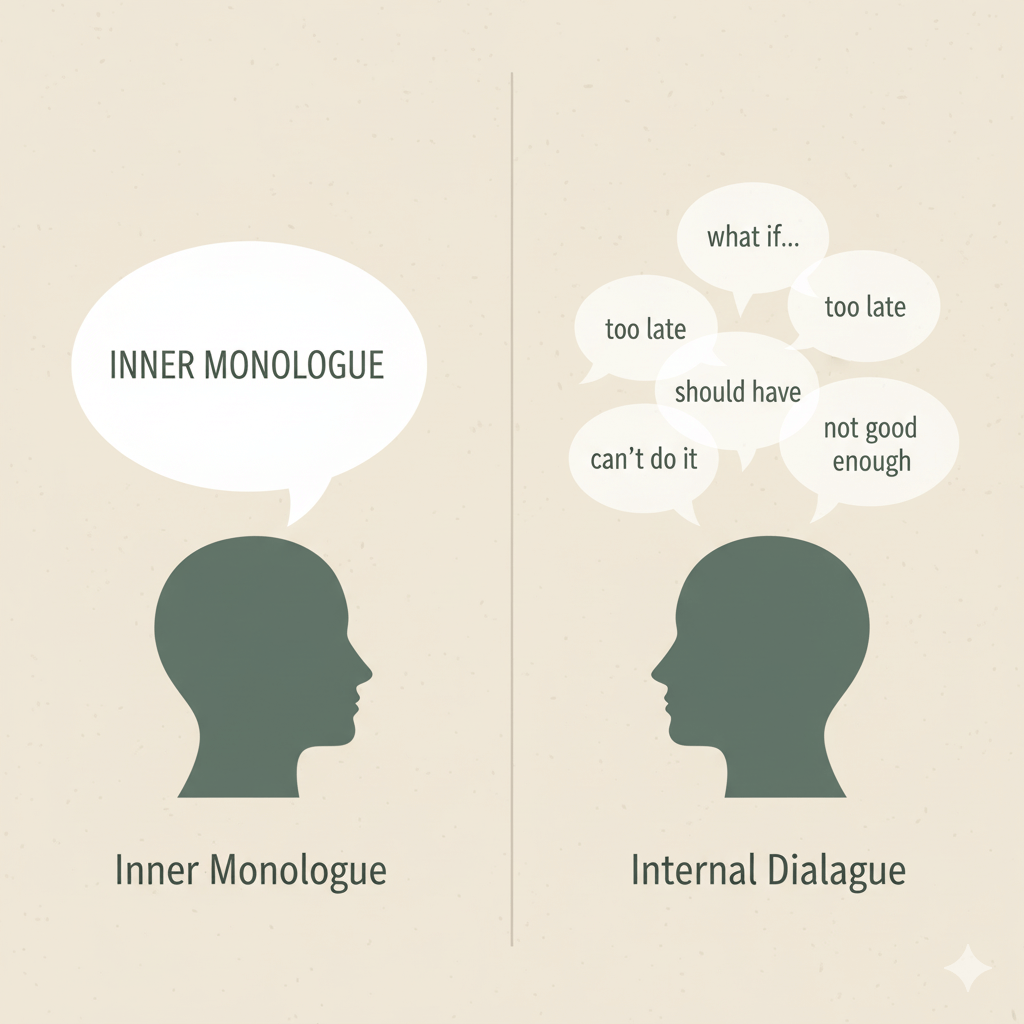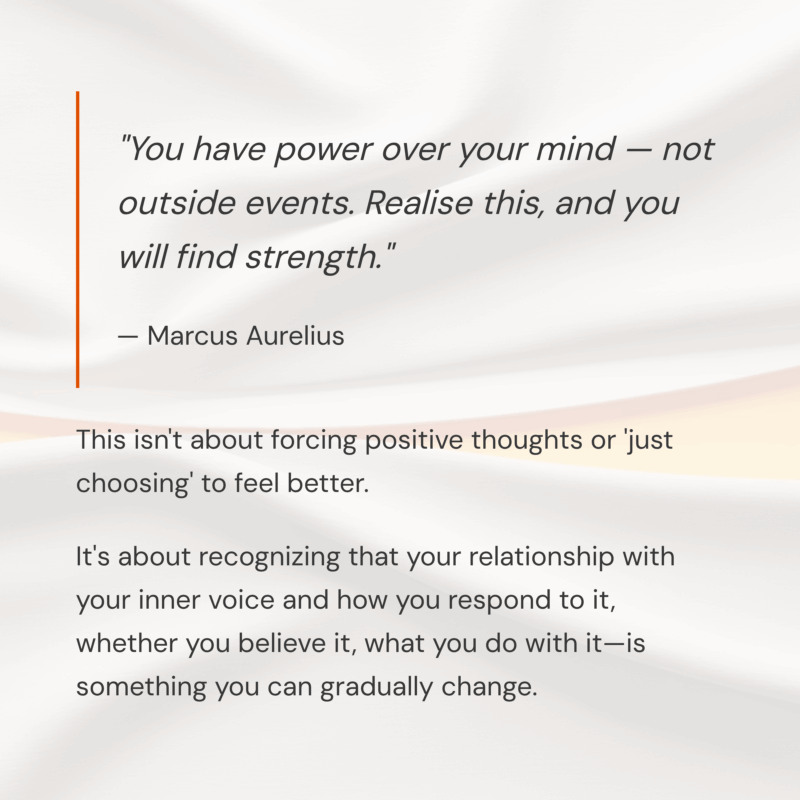Read time: 15 minutes
You’re tired of your own thoughts—your inner monologue
They won’t stop replaying what you said wrong, predicting what might go wrong and then narrating every small failure. That voice in your head you know the one that sounds like you but feels like an enemy, has worn you down.
Most people assume everyone experiences this. They don’t. Only about half of us have a constant inner voice, and for many of us, that voice isn’t kind. It judges you harshly, it imagines the worst. Then keeps you awake at night
If this sounds familiar, you’re not broken. You’re experiencing something specific: a helpful inner monologue that’s transformed into a harmful inner critic. And crucially, you can change your relationship with it.
This guide explores what inner monologue is, why it exists, and how to recognise when it’s working against you instead of for you.

Quick Summary:
Here’s what you need to know:
- What it is: The voice you “hear” in your head when thinking in words—your brain simulating speech internally
- Who has it: Only about 30-50% of people consistently think in words. Others use images, feelings, or direct conceptual understanding
- When it’s a problem: A helpful inner monologue can become a harmful inner critic when it turns relentlessly negative, judgmental, and self-sabotaging
What Is Inner Monologue? (Quick Answer)
Inner monologue—also called internal dialogue or inner speech—is the voice you “hear” inside your head when thinking in words. Your brain simulates speech internally without producing sound. About 30-50% of people experience consistent inner monologue, while others think primarily through visual imagery or feelings.
What does it mean to have inner monologue? It means you experience thoughts as words or sentences in your mind, like having a conversation with yourself. For many people, this inner voice helps with planning, problem-solving, and making decisions throughout the day.
- What Is Inner Monologue? (The Science Explained)
- Do You Have an Inner Monologue? 7 Clear Signs
- What's an Example of Inner Monologue?
- How Many People Have an Inner Monologue?
- What About People Without Inner Monologue?
- Is My Inner Monologue Normal?
- When Does Inner Monologue Become Inner Critic?
- What Your Inner Critic Gets Right (Sort Of)
- The Two Types of Internal Dialogue (And Why It Matters)
- What to Do If Your Inner Monologue Is Constantly Negative
- Frequently Asked Questions
What Is Inner Monologue? (The Science Explained)
Inner monologue—also called internal dialogue, inner speech, or self-talk—is the voice you “hear” inside your head when you think in words.
It’s not a sound you hear with your ears. Your brain creates a simulation of speech. No sound comes out. Your mouth doesn’t move.
Here’s what happens:
When you think “I need to remember to buy milk,” you’re experiencing inner monologue. Your brain uses the same pathways it uses for actual speech. Scientists call this covert speech or verbal thinking. But the signal stays internal.
The Brain Science
Research published in Psychological Science found that a brain signal helps you tell the difference between:
- Sounds from the outside world
- Sounds you create internally (your inner voice)
This is why your inner voice sounds different from hearing a recording of yourself speaking. Your brain knows it’s creating the voice internally. So it processes it differently.
Neuroscientist Mark Scott from the University of British Columbia found that this brain signal is what lets us “hear” ourselves think without making actual sound.
What Inner Monologue Does
Your inner monologue serves several functions:
Planning: “First I’ll do this, then that, then…”
Problem-solving: “If I approach it this way, the result would be…”
Rehearsing: “I’ll say hello, then explain the situation, then…”
Remembering: “Don’t forget keys, wallet, phone”
Self-reflection: “Why did I react that way?”
Decision-making: “Should I do A or B?”
For many, inner monologue is how they make sense of the world and navigate daily life., but not everyone has it.

Do You Have an Inner Monologue? 7 Clear Signs
Not sure if you experience inner monologue? You likely have inner monologue if you:
1. “Hear” Yourself Thinking
When you read these words, do you “hear” them in your head? If yes, that’s inner monologue. Some people just see the words and understand them visually, without any internal voice.
2. You Talk to Yourself in Your Mind
Do you have conversations with yourself?
- “Should I send that email now or later?”
- “What do I want for dinner tonight?”
- “Why did I say that? That was awkward.”
If you’re “speaking” to yourself in your head, you have inner monologue. Is it normal to talk to yourself in your mind? Absolutely, it’s a common way the brain processes information and makes decisions.
3. Get Songs Stuck in Your Head
Can you “hear” a song playing in your mind right now if you try? That’s your inner monologue in action its your brain simulating sound internally.
4. Rehearse Conversations Before Having Them
Do you mentally practice what you’ll say before a difficult conversation or presentation? That’s inner speech helping you prepare.
5. You Read in a “Voice”
When reading, do you “hear” the words as if someone is speaking them? Many people with inner monologue hear each word as they read
(Side note: This can actually slow down reading speed, which is why speed reading courses teach you to suppress it.)
6. You Replay Conversations After They Happen
Do you mentally replay what someone said, hearing their voice in your mind? Or replay what you said and critique it?
7. think in Sentences
When you’re thinking about your day, do your thoughts form into complete sentences? “I need to finish that report, then call Sarah, then…”
If most of these resonate, you definitely have an inner monologue.
If none of this resonates, don’t worry, you’re not broken. You just think differently.
What’s an Example of Inner Monologue?
Inner monologue sounds different for everyone, but here are common examples of what it might “sound” like in your head:
Planning your day: “Okay, first I need to finish that email, then I’ll grab lunch around noon, then I have the meeting at 2pm. I should probably review those notes before the meeting…”
Problem-solving at work: “If I take this approach, I’ll finish faster, but the quality might suffer. But if I do it the thorough way, I’ll miss the deadline. Maybe I can do a hybrid—handle the critical parts carefully and streamline the rest…”
Making a decision: “Should I book the morning or afternoon flight? Morning means I’d have to wake up at 5am, but I’d arrive with the whole day ahead. Afternoon is more relaxed but I’d lose half the day traveling…”
Self-reflection after a conversation: “I shouldn’t have interrupted her like that. She was trying to explain something important and I just jumped in with my opinion. I need to be a better listener.”
Remembering tasks: “Don’t forget to pick up milk on the way home. And call Mum back—I said I’d ring her today. Oh, and respond to that text from James.”
For some people, this internal narration runs almost constantly. For others, it appears only in certain situations. And for about half the population, this doesn’t happen at all, they process information through images, feelings, or direct knowing instead.
How Many People Have an Inner Monologue?
This might surprise you: only 30-50% of people have a consistent inner monologue, according to research by psychologist Russell Hurlburt at the University of Nevada, Las Vegas.
That means roughly half the population doesn’t regularly “hear” themselves think in words.
Do most people have inner monologue? No—it’s actually split fairly evenly. About half the population experiences frequent verbal inner monologue, while the other half thinks primarily through other means.
Hurlburt’s Research
For decades, Hurlburt has studied what he calls pristine inner experience—the unfiltered reality of what’s happening in our minds at any given moment.
His method: Give people beepers that go off at random times. When it beeps, they immediately note what was happening in their mind at that exact moment.
The results? Inner experience is far more diverse than we assume:
- 30-50% report frequent verbal inner monologue
- 20-30% report frequent visual thinking (seeing images, not hearing words)
- 10-20% report sensory awareness (noticing physical sensations)
- 10-15% report feelings without words or images
- Some people report multiple types happening simultaneously
Hurlburt explains: “I’m confident that inner speech is a robust phenomenon; if you use a proper method, there’s little doubt about whether or not inner speech is occurring at any given moment. And I’m confident about the individual differences—some people talk to themselves a lot, some never, some occasionally.”
The Viral Moment
In February 2020, this topic went viral on Twitter when people discovered not everyone thinks the same way internally.
People with inner monologue couldn’t imagine thinking without words. People without inner monologue couldn’t imagine having a constant voice in their head.
Both sides were equally shocked.
Ultimately, there’s no “normal” way to think. Your brain is working perfectly, whether it narrates your life or processes information through images and feelings.

What About People Without Inner Monologue?
If you don’t have inner monologue, you’re not missing anything vital. Your brain just processes information differently.
How Do They Think?
People without inner monologue think in other ways. Instead of words, they use:
Visual thinking: They see a to-do list in their mind. They don’t hear the words “I need to do laundry, buy groceries.” They just see the tasks.
Direct understanding: They grasp ideas without translating them into words first. The concept just clicks.
Feeling-based knowing: They feel what they think rather than putting it into words internally. The thought arrives as an emotion.
Physical intuition: They experience thoughts as body sensations or gut feelings. It’s more felt than heard.
Is One Way Better?
No evidence suggests that having or not having inner monologue makes you smarter, more creative, or better at anything specific. Each thinking style has its trade-offs.
| With Inner Monologue | Without Inner Monologue |
|---|---|
| Easier to organize thoughts into words | Less prone to overthinking or rumination |
| Better at verbal reasoning tasks | Often quicker decision-making |
| Natural self-reflection through “talking it out” | Less vulnerable to verbal self-criticism |
| Can overthink or ruminate more easily | May speak without “thinking through” words first |
| Harder to “turn off” thoughts | Harder to verbally explain thought processes |
| More vulnerable to harsh self-criticism | May need to write things down to organize them |
Neither is superior. They’re just different processing styles.
Is My Inner Monologue Normal?
If you have inner monologue, you might be wondering: “Is mine normal, or is it too much?”
The simple answer is yes, it’s completely normal to have one—just as it’s normal not to. What matters more than its existence is its quality: Is your inner voice a helpful guide or a harmful critic?
Here’s how to tell if yours is healthy or problematic:
Healthy Inner Monologue
Characteristics:
- Comes and goes naturally
- Helps you plan, problem-solve, and reflect
- Mostly neutral or supportive in tone
- You can redirect it when needed
- Includes positive self-talk alongside realistic assessment
- Doesn’t keep you awake at night
Examples:
- “Let me think through this problem step by step”
- “I handled that well—I stayed calm under pressure”
- “That didn’t go as planned, but I learned something”
- “I’ll approach it differently next time”
When Inner Monologue Becomes Problematic: Constant Negative Inner Monologue
Warning signs of a constant inner monologue that’s turned negative:
- Can’t be turned off, runs constantly
- Mostly negative and critical
- Replays painful memories on loop
- Keeps you awake with rumination
- Undermines confidence and self-worth
- Feels like an attack rather than a conversation
Examples:
- “You’re such an idiot for saying that”
- “Everyone thinks you’re a fraud”
- “You’ll never be good enough”
- “You always mess everything up”
When your inner monologue sounds like this, it’s crossed from helpful self-talk into harmful inner critic territory.
If you recognize these patterns, you’re not alone. Many people experience a harsh inner voice that sounds reasonable but actually holds them back.
Can You Turn Off Your Inner Monologue?
Most people with inner monologue can’t “turn it off” completely, but you can quiet it through:
- Meditation and mindfulness
- Physical activity (especially rhythmic exercise)
- Engaging in flow activities (where you’re fully absorbed)
- Listening to music or podcasts
Some report their inner voice goes quiet during these activities, returning only when they “check in” mentally.
If your inner monologue feels relentless and you can never find peace from it, that’s a sign it may have crossed into the problematic territory described above.
Why Does My Inner Monologue Get Louder at Night?
Many people report their inner monologue—especially the critical version—intensifies when trying to sleep.
Why this happens:
- Fewer external distractions (your brain has nothing else to focus on)
- Lower cognitive control (you’re tired, defenses are down)
- Evolutionary wiring (nighttime was historically dangerous, so your brain scans for threats)
- Unprocessed emotions from the day surface
What helps:
- Keep a notepad by your bed for “thought dumps”
- Practice a brief body scan or breathing exercise before sleep
- Address recurring worries during the day rather than ignoring them
- If it persists, speak with a therapist about rumination
When Does Inner Monologue Become Inner Critic?
Here’s the key distinction:
Inner Monologue vs Inner Critic
| Healthy Inner Monologue | Harmful Inner Critic |
|---|---|
| “I made a mistake” | “I am a mistake” |
| “That was difficult” | “I’m too weak/stupid to handle this” |
| “I can learn from this” | “I never learn, I always fail” |
| Observes and reflects | Judges and condemns |
| Temporary feedback | Permanent identity statements |
| Motivates through encouragement | Paralyzes through fear |
| You control the volume | It controls you |
The Transformation Point
Your inner monologue becomes an inner critic when:
- Tone shifts from neutral to harsh
- From: “I could have done better”
- To: “You’re worthless and pathetic”
- Frequency becomes relentless
- It’s no longer occasional reflection but constant commentary
- Content becomes primarily negative
- The ratio tips heavily toward criticism vs support
- Impact becomes destructive
- Instead of helping you improve, it keeps you stuck
- Origin shifts from present to past
- It replays old wounds rather than addressing current situations
Where the Inner Critic Comes From
Often, your inner critic isn’t even your voice. It’s criticism you absorbed from others and made your own. For example, parents, teachers, partners, or authority figures may have sent repeated messages that you weren’t good enough. Your brain recorded these as “truth.”
Here’s what’s crucial: This isn’t your fault.
You didn’t choose this. Your brain was simply doing its job. It learned from your environment and it tried to keep you safe. It absorbed the messages around you, as a child, you had no filter to reject harsh criticism. You believed the adults around you. Even when they were wrong about you.
However, what was learned can be unlearned.
For a deeper exploration of where the inner critic originates and why it sounds so convincing, read Meet Mr Critic: How to Calm Your Inner Critic and Reclaim Your Inner Voice.

Mr Critic Moment:
oh, you mean that full-time employee who never clocks off.”
💬 Reframe: Awareness is progress. You’re starting to notice the noise rather than believe it.
What Your Inner Critic Gets Right (Sort Of)
Before we talk about managing your inner critic, there’s something important to understand:
Your inner critic usually has a real concern buried beneath the harshness. The problem? It’s not the worry itself. It’s the cruel delivery.
In other words, the critic isn’t wrong about what matters to you. It’s just terrible at expressing it.
Translating Criticism Into Concern
The key is learning to ask: “What’s the actual concern here?”
Harsh voice says: “You’re going to fail and everyone will think you’re an idiot”
Actual concern underneath: “I want to do well and be respected”
The actionable response: “This matters to me, so I’ll prepare thoroughly”
Harsh voice says: “You’re so lazy, you never finish anything”
Actual concern: “I have goals I care about completing”
The actionable response: “I want to build better follow-through habits”
Harsh voice says: “Nobody likes you, you’re always awkward”
Actual concern: “I want meaningful connections with people”
The actionable response: “I’m learning how to connect authentically”
Why This Matters
When you separate the concern from the cruelty, you can address the real worry. No mental damage needed.
The critic isn’t the voice of truth. It’s a scared part of you expressing worry badly.
Think of it this way: You’re not destroying an enemy. You’re retraining a guard dog that’s been biting you instead of actual threats.
Once you see that it’s trying to protect you but just doing it badly then you can start to change things
For a deeper exploration of the inner critic’s origins, fears, and three quick actions you can take today to start reclaiming your inner voice, read Meet Mr Critic: How to Calm Your Inner Critic and Reclaim Your Inner Voice.

The Two Types of Internal Dialogue (And Why It Matters)
Psychologists distinguish between two forms of inner experience:
1. Inner Monologue (One Voice)
This is what we’ve mostly discussed—a single internal voice that narrates, plans, and reflects.
Characteristics:
- Sounds like “you” talking to yourself
- Usually your own voice (though the tone may vary)
- Linear: one thought follows another
- Verbal: uses words and sentences
Example: “Okay, I need to finish this email, then grab lunch, then call back that client…”
2. Internal Dialogue (Multiple Voices)
Some people experience actual internal conversations—different perspectives debating inside their head.
Characteristics:
- Multiple distinct voices or perspectives
- Back-and-forth exchange
- Can feel like different “parts” of yourself talking
- More complex than simple monologue
Example:
The internal debate might sound like: “I should stay home and rest, I’m exhausted.” Then another voice responds: “But you promised you’d go, they’re counting on you.” The first voice pushes back: “They’ll understand if I cancel.” But the second voice persists: “Will they though? You’ve cancelled before…”
This is called dialogical self-talk, and it’s actually quite common.
Why This Matters for the Inner Critic
When you have internal dialogue (multiple perspectives), one of those voices often becomes the inner critic—the harsh, judgmental one.
The goal isn’t to destroy that voice. It’s to:
- Recognize it as just one perspective, not absolute truth
- Strengthen other, more compassionate voices
- Create balance in the internal conversation
If your inner dialogue feels like a hostile takeover—where the critical voice drowns out all others—that’s when intervention helps.
When you’re ready to turn that awareness into calm daily practice, try Stoic reflection.

What to Do If Your Inner Monologue Is Constantly Negative
Once you understand the critic, the next step is to retrain it. If your inner monologue is constantly negative, you’re not stuck with it forever.
Everyday Mastery Steps You Can Take Now
These aren’t fixes, they’re gentle shifts.
Notice Tone Before Content
When the voice speaks, pause and ask yourself: Would I say this to someone I love?
If not, why am I saying it to myself?
This simple awareness creates distance. You’re not trying to argue with the thought or prove it wrong—just observing that the tone is harsh.
Name the Feeling Beneath the Words
Often, harsh self-talk is covering up a different emotion:
- “Lazy” actually means “tired” or “overwhelmed”
- “Failure” means “afraid of disappointing myself or others”
- “Useless” means “unsupported” or “I need help”
When you catch criticism, ask: “What am I actually feeling right now?”
Offer Curiosity, Not Correction
Instead of arguing with the critic or trying to silence it, get curious:
“That’s interesting, inner critic. What are you trying to protect me from right now?”
This shifts you from being at war with yourself to understanding what’s driving the harsh voice.
You’re not trying to mute the voice—you’re trying to mature it.

Journalling Prompt:
How would that message sound if it came from someone who loved you
When your inner voice speaks, whose tone does it sound like?
What’s one thing your inner voice says often — and what might it really be trying to protect you from?
Frequently Asked Questions
What is inner monologue?
Inner monologue is the experience of “hearing” your thoughts as words or sentences in your head. It’s not actual sound—your brain simulates speech internally without producing noise. About 30-50% of people experience consistent inner monologue, using it for planning, problem-solving, rehearsing conversations, and self-reflection.
Is it normal to have inner monologue?
Yes, it’s completely normal to have inner monologue—about 30-50% of people experience it regularly. However, it’s equally normal NOT to have one. Some people think primarily through visual imagery, feelings, or direct conceptual understanding rather than words. Both ways of thinking are equally valid and functional.
The only concern is if your inner monologue becomes mostly negative, critical, and constant—which indicates it has crossed into harmful inner critic territory.
Is inner monologue linked to anxiety or depression?
Inner monologue itself isn’t a symptom of mental illness—it’s just how some brains process information.
However, rumination (repetitive negative inner monologue) is strongly linked to both anxiety and depression. Research in clinical psychology distinguishes between:
- Normal inner monologue: comes and goes, helps you process information
- Rumination: stuck on repeat, keeps you trapped in past pain or future worry
If your inner monologue feels like rumination, therapeutic approaches like Cognitive Behavioral Therapy (CBT) and mindfulness-based interventions have strong evidence for helping retrain thought patterns.
Why is my inner monologue in a different voice?
Some people report their inner monologue sounds like:
- A parent’s voice
- Past teacher or authority figure
- A generic “narrator” rather than their own voice
- Multiple different voices depending on context
This often happens because you’ve internalized someone else’s criticism or guidance. Your brain stored their voice along with their message, and now it replays automatically.
This is actually helpful information—it shows you where the harsh messages originated, and reminds you they’re not objectively true about you.
Can you develop inner monologue if you don’t have it?
There’s limited research on this, but some people report developing more verbal inner speech over time, especially:
- After learning a second language
- Through journaling practices
- During therapy that involves “externalizing” thoughts
- As they age (some children develop it during language acquisition)
That said, there’s no reason to force it. People without inner monologue function perfectly well.
Is inner monologue the same as talking to yourself out loud?
Not quite. Inner monologue is silent—it happens entirely in your mind.
Talking to yourself out loud (called private speech or external self-talk) is different and actually quite useful for:
- Working through complex problems
- Staying focused on tasks
- Regulating emotions
- Improving performance under pressure
Research shows talking to yourself in the third person (“You can do this, [your name]”) is more effective than first person (“I can do this”) for emotional regulation.
What triggers inner monologue?
Inner monologue typically activates during:
- Planning and decision-making: When you need to think through options or organize tasks
- Problem-solving: When working through complex issues that benefit from verbal reasoning
- Self-reflection: After social interactions or when processing emotions
- Reading: Many people with inner monologue “hear” the words as they read
- Stress or uncertainty: The voice often gets louder when you’re anxious or facing difficult decisions
For some people, inner monologue runs almost constantly. For others, it only appears in specific situations. There’s no “right” amount—what matters is whether it helps or hinders you.
The Bottom Line
Inner monologue is normal. About 30-50% of people experience it, while others think differently—neither is better.
Internal dialogue in words can be helpful—for planning, problem-solving, and self-reflection.
But when that voice becomes predominantly harsh, critical, and relentless, it’s crossed into inner critic territory.
You’re not broken for having negative self-talk. You’re human.
What matters most is that this voice can be retrained.
It won’t happen overnight. Changing entrenched thought patterns takes months, sometimes years, of consistent practice. But every time you catch the critic, name it, and respond with compassion instead of belief, you’re rewiring your brain.
The inner critic isn’t your enemy—it’s a misguided protector that learned the wrong lessons. Your job isn’t to destroy it. It’s to teach it a new way to keep you safe: through encouragement instead of attack, through truth instead of distortion, through compassion instead of cruelty.
Your inner voice doesn’t have to be your enemy. With patience and practice, it can become your ally.
If you found this guide helpful and want to understand the specific character of the inner critic—why it sounds so reasonable, what it’s really afraid of, and quick actions you can take today to start retraining it—read Meet Mr Critic: How to Calm Your Inner Critic and Reclaim Your Inner Voice.
Getting help
These small steps can begin to shift your relationship with your inner voice, but they’re not sufficient for everyone.
Seek professional support if:
- Inner monologue includes persistent thoughts of self-harm or suicide
- You hear voices that feel external (not your internal monologue, but as if someone else is speaking)
- Negative thoughts completely prevent you from functioning (work, relationships, self-care)
- Have intrusive thoughts that feel out of your control
- Your inner critic is linked to trauma that needs professional processing
UK resources:
If you’re in the UK, your GP can refer you to NHS Talking Therapies, where you can access free evidence-based treatment. Need to talk to someone now? The Samaritans are there 24/7 on 116 123—no judgment, just listening. Mind (mind.org.uk) is also a brilliant resource for understanding your options and finding local support.
Therapy approaches that work for harsh inner critics:
- Cognitive Behavioral Therapy (CBT): Excellent for identifying and reframing distorted thinking patterns. Research shows CBT effectively reduces rumination and negative self-talk.
- Compassion-Focused Therapy (CFT): Specifically designed to address harsh self-criticism by developing self-compassion skills.
- Internal Family Systems (IFS): Works with different “parts” of yourself, including the critic, treating each as a protective mechanism.
- Acceptance and Commitment Therapy (ACT): Helps you defuse from thoughts rather than fighting them, creating psychological flexibility.
The right support can accelerate transformation significantly.
About Everyday Mastery
Everyday Mastery blends science, mindfulness, and small daily actions to help you build habits that last.
Found this helpful? You can buy me a coffee to support more writing like this.
Disclaimer
This article is based on peer-reviewed research and personal experience. It is not medical advice and won’t work for everyone. I’m not a therapist or psychologist.
Kel is the writer behind Everyday Mastery, where she shares the real, messy, and meaningful process of building habits, resilience, and self-belief from the ground up. Her writing blends ancient philosophy with modern science, always focused on small, practical steps that lead to lasting





